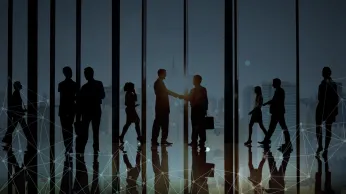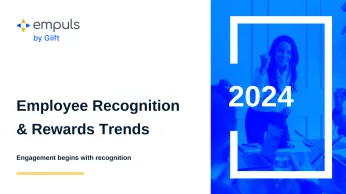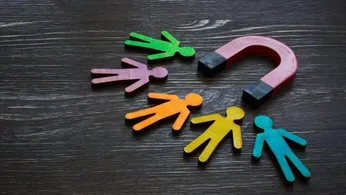Memahami Model Gunung Es Budaya untuk Mendorong Keberhasilan Organisasi
Pada tahun 1976, Edward T Hall mengembangkan 'Model Gunung Es Budaya' dan menjelaskan bahwa budaya organisasi seperti gunung es yang ditemukan di laut kutub. Apa yang Anda lihat hanyalah puncak gunung es. Di bawahnya terdapat massa yang sangat besar dan tak terlihat, yang menyatukan semuanya dengan kuat.
Di halaman ini
Model gunung es budaya atau gunung es budaya digunakan sebagai metafora yang umum, tetapi seberapa baik Anda mengetahuinya? Sebelum kita mendalami lapisan-lapisannya dan signifikansinya dalam sebuah organisasi, mari kita pahami secara umum.
Orang sering menganggap budaya sebagai berbagai karakteristik yang dapat diamati dari perusahaan tertentu yang mereka lihat dengan mata kepala sendiri-tunjangan, tunjangan, aturan berpakaian, lingkungan kantor, fasilitas, lokasi, dan orang-orangnya.
Namun, kenyataannya, semua itu hanyalah manifestasi eksternal dari komponen budaya yang lebih luas dan lebih dalam: ide-ide yang rumit, prioritas dan preferensi yang tertanam kuat, yang dikenal sebagai nilai dan sikap.
Jauh di bawah 'garis air' terdapat massa yang sangat besar dan tak terlihat, yang menyimpan setiap asumsi budaya yang sudah mendarah daging dan sulit untuk dipengaruhi. Sederhananya, ini adalah ideologi atau nilai-nilai inti organisasi.
Ini adalah gagasan utama yang dipelajari tentang apa yang baik, buruk, benar, salah, diinginkan, tidak diinginkan, dapat diterima, dan tidak dapat diterima. Pada akhirnya, hal ini hanya dapat dilihat dari cara orang bertindak, kata-kata yang mereka gunakan, hukum yang mereka terapkan, dan cara mereka berkomunikasi.
Tidak heran jika budaya organisasi adalah penyebut umum yang membedakan organisasi dengan kinerja terbaik dari yang lain.
Sekarang setelah Anda memiliki gambaran yang lebih jelas mengenai teori gunung es budaya, mari kita pahami bagaimana teori ini dapat membantu mendorong kesuksesan organisasi.
Apa itu budaya organisasi dan Bagaimana budaya organisasi dapat mendorong kesuksesan organisasi
Budaya organisasi adalah serangkaian keyakinan dan nilai yang mendorong apa yang dilakukan orang dan bagaimana mereka melakukannya. Budaya adalah norma implisit yang menentukan jenis perilaku karyawan yang diterima, ditolak, didorong, atau dilarang dalam organisasi.
Meskipun kebijakan dan buku panduan karyawan yang disusun oleh HR dapat memandu perilaku lahiriah karyawan, mengubah budaya organisasi secara positif dapat memengaruhi cara karyawan memperlakukan satu sama lain, berkomunikasi satu sama lain, menyelesaikan sesuatu, dll.
Budaya, sebagai sebuah kata, menggambarkan cara orang hidup di suatu tempat, namun ada berbagai cara untuk melihatnya. Mari kita pahami dari perspektif organisasi dan bagaimana model gunung es budaya memengaruhi orang-orang di tempat kerja.
Apa yang dimaksud dengan model gunung es budaya
Model gunung es budaya adalah kerangka kerja yang memungkinkan Anda untuk mengukur budaya organisasi Anda. Model ini membantu menilai seberapa baik nilai-nilai budaya organisasi selaras dengan tujuan dan memecahkan masalah kinerja.
Pada tahun 1976, Edward T Hall mengembangkan 'Model Gunung Es Budaya' dan menjelaskan bahwa budaya organisasi seperti gunung es yang ditemukan di laut kutub. Seperti gunung es, budaya perusahaan memiliki karakteristik yang sangat tidak proporsional dalam hal visibilitas aktualnya.
Sementara beberapa aspek budaya mudah dilihat dari luar, sering disebut budaya permukaan, apa yang membentuk fondasi budaya yang kuat sering kali tenggelam, lebih dalam di dalam nilai-nilai dan keyakinan organisasi, yang disebut "budaya yang lebih dalam."
Aspek-aspek seperti suasana tempat kerja, cara berpakaian, sistem, kebijakan, dan proses terlihat di permukaan, namun elemen-elemen seperti nilai dan keyakinan bersama, sikap terhadap otoritas, persaingan, dan asumsi-asumsi yang mendasari membentuk budaya yang lebih dalam.
Lapisan-lapisan model gunung es budaya
Sekarang mari kita selami lebih dalam berbagai lapisan budaya ini - baik di permukaan maupun yang lebih dalam - dan pahami bagaimana budaya dapat membantu mencapai tujuan organisasi.
Setiap kali Anda bertanya kepada seseorang, "Seperti apa budaya kerja di sini?" kemungkinan besar Anda akan mendengar jawaban seperti "Oh, keren, kami memiliki ruang permainan yang luar biasa, konter makanan ringan yang lengkap, pizza gratis, dll." atau "Saya menyukainya!
Tidak ada aturan berbusana, saya senang mengenakan celana pendek ke kantor, dan jam kerja yang fleksibel sungguh menyenangkan!" atau hal-hal serupa. Ini adalah persepsi yang dibentuk oleh orang-orang berdasarkan apa yang mereka lihat, dengar, atau rasakan tentang budaya organisasi dan kepemimpinan.
Aspek-aspek yang terlihat dari budaya organisasi seperti itu biasanya memberikan petunjuk tentang apa yang dipercayai oleh organisasi tersebut dan bagaimana organisasi tersebut dijalankan.
Sekarang, mari kita jelajahi aspek budaya permukaan:
1. Fasilitas dan manfaat
Sebagai sebuah organisasi, apakah Anda mempromosikan keseimbangan antara pekerjaan dan kehidupan pribadi? Apakah Anda mempromosikan budaya jam kerja yang fleksibel? Apakah Anda mendorong karyawan untuk mengambil langkah maju menuju kesejahteraan mereka?
Sebagian besar organisasi yang sukses berusaha keras untuk menciptakan budaya yang memastikan karyawan mereka merasa nyaman dalam semua aspek kehidupan mereka. Tunjangan dan manfaat karyawan memainkan peran besar dalam mewujudkan hal ini.
Baik bekerja dari rumah, mengikuti retret perusahaan/tim secara rutin, atau pengaturan kerja yang fleksibel, tunjangan dan manfaat secara signifikan memengaruhi perilaku dan keterlibatan karyawan. Sebuah penelitian menunjukkan bahwa 48% orang yang berpindah kerja akan mempertimbangkan tunjangan sebagai bagian penting dalam pengambilan keputusan mereka - meskipun tunjangan tersebut sekecil snack bar gratis.
2. Pakaian dan penampilan
Bagaimana tenaga kerja Anda datang ke kantor - apakah mereka mengenakan pakaian formal sepanjang waktu atau celana jins/kemeja atau apakah Anda semua mengenakan seragam ke kantor? Bagaimana Anda mengharapkan penampilan karyawan Anda?
Gaya berpakaian dan penampilan karyawan dapat memiliki dampak besar pada bagaimana budaya organisasi dipersepsikan. Sudah hampir beberapa dekade sejak aturan berpakaian formal menjadi konsep yang ketinggalan zaman.
Saat ini, sebagian besar perusahaan melonggarkan aturan berpakaian mereka untuk mendorong karyawan agar berpakaian santai dan merasa nyaman dengan sepatu mereka (permainan kata-kata) untuk meningkatkan produktivitas.
3. Teknologi
Apakah teknologi yang Anda gunakan selaras dengan tujuan dan strategi perusahaan? Apakah Anda juga menggunakan teknologi untuk memperkuat budaya organisasi?
Teknologi yang digunakan dalam sebuah organisasi memainkan peran penting dalam mendefinisikan budaya organisasi. Teknologi dapat membuat organisasi terlihat 'keren dan cerdas' atau 'kuno dan kaku'.
Meskipun teknologi tidak dapat menciptakan atau mengubah budaya organisasi secara sendirian, teknologi berperan sebagai alat yang penting untuk memperkuat budaya di antara para karyawan. Hal ini mencerminkan dan membentuk nilai dan asumsi sekaligus menjaga organisasi tetap relevan untuk tenaga kerja di masa depan.
4. Bahasa
Isyarat apa yang Anda gunakan untuk berkomunikasi tentang organisasi Anda? Bagaimana nada atau nada pesan Anda? Bagaimana organisasi Anda terlihat oleh orang lain?
Bahasa menunjukkan budaya melalui cara berbicara (sopan atau kasar?), perilaku (formal atau santai?), penyampaian (langsung atau tidak langsung?), dan pilihan kata (bersih, ceplas-ceplos, atau sombong?).
Cara kita memilih untuk berkomunikasi dengan orang lain dapat secara signifikan memengaruhi bagaimana budaya organisasi terlihat oleh orang-orang. Oleh karena itu, pilihlah rangkaian kata, gerak tubuh, nada, dan platform komunikasi yang tepat.
5. Penghargaan dan pengakuan
Penghargaan dan pengakuan memiliki dampak yang sangat besar pada pengalaman karyawan dan budaya organisasi. Mereka menciptakan persepsi di antara orang-orang tentang apa yang diperjuangkan oleh organisasi, nilai-nilainya, dan keyakinannya.
Siapa di dalam organisasi yang mendapatkan penghargaan/pengakuan dan mengapa-mewakili pernyataan tegas tentang nilai-nilai dan budaya organisasi yang sebenarnya.
Penghargaan dan pengakuan memperkuat bahwa pekerjaan itu bermakna dan berharga bagi organisasi. Hal ini membantu karyawan menemukan fokus dan tujuan dalam kegiatan sehari-hari mereka - sehingga meningkatkan motivasi karyawan.
Kita semua cenderung memecah informasi yang rumit dan menggeneralisasi apa yang kita lihat dan dengar untuk mendapatkan kesimpulan yang lebih mudah. Budaya permukaan adalah aspek budaya yang direfleksikan oleh orang luar - memberikan jalan pintas untuk mengidentifikasi bagaimana segala sesuatunya dilakukan dalam sebuah organisasi.
Namun, apa yang kita lihat di permukaan mencerminkan organisasi yang dibangun di atas nilai-nilai, keyakinan, dan asumsi dasar yang mendorong perilaku karyawan.
Setiap organisasi dibangun di atas aturan dan karakteristik khas yang mendefinisikannya. Meskipun tidak terlihat oleh dunia luar, karakteristik ini dapat membuat atau menghancurkan organisasi.
Ini adalah aspek-aspek budaya yang lebih dalam yang dibangun di atas keyakinan dan nilai, bias dan paksaan, otoritas dan persaingan, kesehatan dan kesejahteraan, dan berbagai faktor lain yang tidak dapat dengan mudah dilihat atau dievaluasi sebagai faktor eksternal.
Sebagai contoh, saat Anda mengambil pekerjaan baru setelah meneliti perusahaan secara menyeluruh, beberapa kali wawancara, dan percakapan dengan berbagai orang di dalam organisasi, Anda cenderung membentuk ekspektasi tertentu mengenai organisasi tersebut.
Namun, begitu berada di dalam, segala sesuatunya tidak selalu seperti yang Anda harapkan. Anda mungkin akan menemukan aturan dan kebiasaan yang tidak pernah disebutkan sebelumnya. Hal ini dikarenakan adanya keyakinan dan nilai dasar organisasi yang membentuk budaya yang lebih dalam.
Kepemimpinan sebuah organisasi memiliki dampak yang besar dalam menyebarluaskan budaya yang lebih dalam melalui tindakan, keputusan, keyakinan, dan perilaku mereka.
Di sini, kami membahas beberapa aspek budaya yang lebih dalam yang mendorong sebuah organisasi.
1. Wewenang
Apakah karyawan di organisasi Anda merasa bahwa mereka memiliki wewenang pengambilan keputusan yang tepat? Apakah karyawan Anda merasa bahwa pendapat mereka didengar dalam proses pengambilan keputusan?
Sebagian besar organisasi yang sukses melibatkan karyawan dalam proses pengambilan keputusan. Mereka terbuka untuk mendengarkan pendapat dan umpan balik dari karyawan, yang secara signifikan berdampak pada budaya organisasi.
Karyawan merasa sangat dihargai ketika pandangan mereka didengar dan didorong untuk berpartisipasi dalam pengambilan keputusan. Rasa memiliki otoritas dirasakan ketika mereka terlibat dalam diskusi dan tugas yang berdampak pada pertumbuhan organisasi, yang mengarah pada tingkat kepuasan kerja yang lebih tinggi.
2. Kesehatan dan kesejahteraan
Apa filosofi organisasi Anda tentang kesehatan dan kesejahteraan? Apakah Anda mendorong karyawan Anda untuk membuat pilihan yang lebih sehat? Apakah Anda mendukung mereka dalam membuat pilihan?
Organisasi di seluruh dunia semakin menyadari peran penting kesejahteraan karyawan dalam melibatkan karyawan dan menumbuhkan budaya tempat kerja yang kuat. Baik itu kesehatan fisik, emosional, mental, maupun finansial, semuanya berdampak signifikan terhadap keterlibatan dan budaya karyawan.
Karyawan yang bahagia dan sehat telah terbukti mendorong produktivitas yang lebih baik serta mengurangi biaya perawatan kesehatan dan tingkat keluar masuknya karyawan. Program kesejahteraan karyawan sangat penting untuk membangun tenaga kerja yang lebih bahagia, yang pada akhirnya akan meningkatkan keuntungan Anda.
Namun, hanya dengan memiliki program atau inisiatif saja tidak akan secara ajaib meningkatkan kesejahteraan. Organisasi harus menjadikannya sebagai bagian dari budaya organisasi dan secara teratur menilai dampaknya untuk menggerakkan jarum dan memberikan hasil.
3. Tujuan dan makna
Apakah karyawan Anda memahami pentingnya visi dan misi organisasi Anda? Apakah mereka tahu bagaimana peran pekerjaan mereka berkontribusi pada kebaikan yang lebih besar?
Tujuan dan makna adalah bagian dari gunung es budaya organisasi yang semakin penting belakangan ini, berkat meningkatnya jumlah generasi milenial dalam organisasi.
Membantu karyawan memahami misi organisasi, membantu mereka terlibat, dan membuat mereka menyadari bahwa mereka adalah bagian dari sesuatu yang lebih besar sangat penting bagi setiap organisasi. Ketika karyawan tahu mengapa mereka melakukan apa yang mereka lakukan, hal ini dapat mendorong keterlibatan, motivasi, dan hasil bisnis yang fenomenal.
4. Komunikasi
Apakah Anda sering dan secara konsisten berkomunikasi dengan tim Anda tentang apa yang sedang terjadi? Seberapa transparan komunikasi Anda? Apakah Anda cukup mendengarkan tim Anda?
Komunikasi merupakan bagian integral dari budaya organisasi. Organisasi yang mengadopsi komunikasi yang terbuka, transparan, positif, dan kuat akan memupuk hubungan kerja yang sehat sehingga mengurangi konflik dan hal-hal negatif.
Budaya komunikasi yang sehat dan efektif membuka saluran (antara karyawan dan manajemen) untuk pertukaran ide, saran, dan umpan balik yang sehat.
5. Keterlibatan karyawan
Apakah Anda menghargai tenaga kerja Anda sebagai kontributor utama bagi kesuksesan organisasi? Apakah Anda memahami denyut nadi karyawan Anda? Apakah Anda menyediakan suasana yang kondusif bagi karyawan untuk terlibat?
Budaya organisasi memiliki dampak yang kuat pada karyawan. Budaya yang positif dan terbuka dapat menciptakan kepercayaan dan kesetiaan di antara karyawan, mendorong semangat dan dedikasi kepada organisasi.
Ketika organisasi secara proaktif menerima umpan balik dari karyawan dan mengambil jalur komunikasi terbuka untuk secara proaktif menyampaikan pesan-pesan penting tentang PHK, kenaikan gaji, restrukturisasi, dll., secara singkat, hal ini akan meyakinkan karyawan dan meningkatkan keterlibatan.
Penelitian mengatakan bahwa karyawan merasa terlibat ketika mereka diinvestasikan dalam masa depan dan budaya perusahaan mereka, merasa bahwa pekerjaan mereka memberi mereka tujuan, dan memiliki hubungan yang baik dengan rekan kerja mereka.
6. Pembelajaran dan pengembangan
Apakah Anda menekankan pembelajaran dan pengembangan dalam organisasi Anda? Apakah Anda memberikan kesempatan belajar dan berkembang yang cukup bagi karyawan Anda? Apakah karyawan Anda tertantang dengan proyek-proyek baru dan menarik?
Jika ada satu ciri budaya yang akan dijamin oleh setiap pemimpin yang sukses, yaitu memprioritaskan pembelajaran dan pengembangan di antara para karyawan. Hal ini tidak hanya mendorong pemikiran inovatif dan kreativitas, namun juga meningkatkan kelincahan bisnis untuk mempertahankan diri dalam lingkungan bisnis yang semakin kompleks dan terus berubah.
7. Kolaborasi dan kerja sama tim
Apakah Anda mendorong karyawan Anda untuk bekerja secara lintas fungsi, lintas tim? Apakah ada definisi yang jelas tentang kepemilikan untuk bekerja di lingkungan lintas fungsi?
Memupuk kerja sama tim, semangat tim, dan kolaborasi merupakan bagian dari budaya organisasi yang menghargai karyawan yang bekerja sama untuk mencapai tujuan organisasi. Organisasi yang membangun budaya kerja sama tim percaya bahwa perencanaan, pemikiran, dan pengambilan keputusan akan lebih baik jika dilakukan secara kolektif daripada secara individu.
Menjadikan kolaborasi dan kerja sama tim sebagai bagian dari budaya organisasi Anda membutuhkan dukungan dari semua karyawan. Menerapkan rencana yang menjabarkan berbagai dinamika kolaborasi, kepemilikan, kerja sama tim, dan secara teratur mendorong dan menghargai kerja sama tim dapat membantu menjadikan konsep ini sebagai bagian dari budaya perusahaan Anda.
Ini hanyalah beberapa aspek indikatif dari apa yang membentuk budaya organisasi. Memahami dan mengimprovisasi budaya dalam organisasi Anda dapat menjadi hal yang penting untuk mendorong kesuksesan.
Bagaimana Empuls membantu memperkuat budaya organisasi - baik di atas maupun di bawah permukaan
Memahami model gunung es budaya mengungkapkan bahwa menciptakan budaya organisasi yang hebat bukan hanya tentang tunjangan yang terlihat saja-ini juga tentang memelihara nilai-nilai dan keyakinan yang tertanam kuat yang benar-benar mendorong perilaku karyawan. Di sinilah Empuls, sebuah platform keterlibatan karyawan yang lengkap, menjadi sekutu yang kuat bagi para pemimpin SDM.
Empuls membantu organisasi secara aktif membentuk lapisan permukaan dan lapisan yang lebih dalam dari budaya dengan menyediakan alat yang melampaui taktik keterlibatan sederhana dan menyelami apa yang benar-benar penting-koneksi, pengakuan, umpan balik, dan tujuan.
Memperkuat budaya permukaan dengan pengalaman nyata
Empuls menyediakan cara yang mudah untuk memberikan tunjangan yang berarti, manfaat yang fleksibel, dan budaya penghargaan yang dapat dilihat dan dirasakan oleh karyawan setiap hari. Baik itu pengakuan atas pekerjaan yang dilakukan dengan baik, perayaan ulang tahun, atau inisiatif kesehatan, simbol-simbol kepedulian dan penghargaan ini sangat membantu dalam menciptakan budaya yang terlihat dan positif.

Dengan Empuls, Anda dapat menerapkan pengenalan peer-to-peer, aktivitas keterlibatan yang di-gamifikasi, dan bahkan penghargaan khusus-membuat nilai-nilai budaya terlihat dalam tindakan.
Memperkuat budaya yang lebih dalam melalui koneksi dan penyelarasan
Apa yang tidak terlihat di lapisan budaya yang lebih dalam-seperti sikap karyawan, rasa memiliki tujuan, nilai-nilai, dan rasa memiliki-dapat diperkuat dengan komunikasi yang konsisten dan keterlibatan yang disengaja. Empuls memungkinkan organisasi untuk mendorong komunikasi yang transparan, mengukur sentimen karyawan, mengumpulkan umpan balik secara teratur, dan menyelaraskan setiap inisiatif dengan nilai-nilai inti.

Survei dan pemeriksaan denyut nadi terintegrasiEmpuls membantu organisasi memahami pendorong emosional dan psikologis di balik tindakan karyawan, menciptakan ruang untuk perbaikan berkelanjutan dan penyelarasan budaya.
Mengaktifkan budaya dengan desain, bukan secara default
Budaya tidak boleh dibiarkan begitu saja. Dengan Empuls, Anda mendapatkan akses ke wawasan berbasis data, membantu para pemimpin dan manajer SDM secara proaktif mengelola dan memengaruhi budaya organisasi.

Mulai dari meningkatkan semangat kerja dengan pengakuan tepat waktu hingga menciptakan lingkaran umpan balik yang mendorong transparansi dan kolaborasi, Empuls mendukung desain yang disengaja untuk menciptakan budaya berkinerja tinggi.
Pikiran terakhir
Dengan memahami teori gunung es tentang budaya, kita dapat mengetahui akar penyebab masalah di perusahaan dan mengubah perilaku manusia dalam skala besar. Budaya organisasi memiliki dampak yang sangat besar terhadap keterlibatan karyawan, produktivitas, kinerja, dan pengalaman kerja secara keseluruhan.
Memahami nuansa budaya organisasi dapat memberdayakan Anda untuk meningkatkan kinerja organisasi secara keseluruhan. Meskipun hanya sebagian kecil dari budaya yang tercermin di atas permukaan agar orang dapat melihatnya, nilai-nilai dan keyakinan yang lebih dalam dapat mendorong organisasi menuju kesuksesan.
Perilaku, keyakinan, dan tindakan kepemimpinan memainkan peran penting dalam mempengaruhi budaya dalam organisasi dan mendorong strategi organisasi.
Ketika strategi-budaya-kepemimpinan selaras, kita akan melihat organisasi di mana:
- Karyawan memahami bagaimana pimpinan mengharapkan mereka untuk merespons situasi tertentu,
- Karyawan benar-benar percaya bahwa respons yang diharapkan adalah pendekatan yang tepat, dan
- Karyawan yakin bahwa mereka akan dihargai karena telah menunjukkan nilai-nilai dan keyakinan organisasi.













